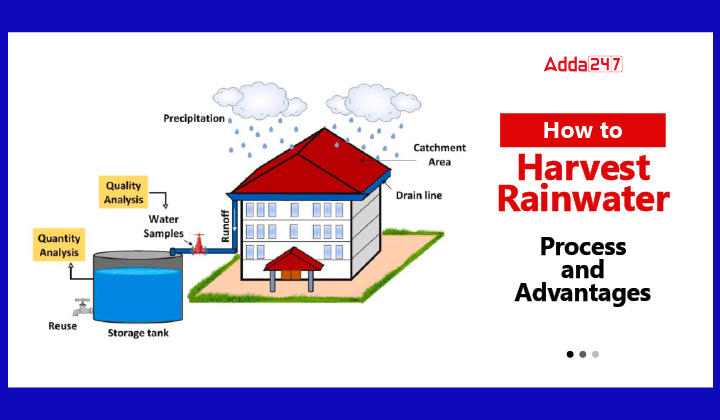Table of Contents
Rainwater harvesting is a straightforward technique or technology that collects, conveys, purifies, and stores runoff from rooftops, parks, highways, open spaces, etc. for use in the future. Rainwater harvesting remains a valuable water conservation practice that can help alleviate water scarcity and reduce the burden on traditional water sources. Proper planning, design, and maintenance can help mitigate many of these challenges and make rainwater harvesting an effective and sustainable water management solution. Read below to understand the processes involved to harvest rainwater as well as its advantages.
How to Harvest Rainwater: Overview
Water is a necessity for all living things, including plants, animals, and humans, to survive and perform various biological functions.
- The ecosystem’s most valuable, necessary, and abiotic component is water.
- Today, water is becoming increasingly scarce, and this is largely due to a lack of water conservation efforts and water body pollution.
- The idea is to start conserving water now so that we don’t squander any of it.
Process to Harvest Rainwater
Rainwater harvesting is the process of gathering and storing rainwater using artificially constructed systems that run off naturally occurring or created catchment areas. They include roofs, buildings, rock surfaces, hill slopes, or artificially repaired impervious or semi-pervious land surfaces.
The process to harvest rainwater & components required for the same have been explained below:
- Catchment – Used to collect and store the collected rainwater.
- Conveyance system – It is used to transport the harvested water from the catchment to the recharge zones.
- Flush – It is used to flush out the first drops of rain.
- Filter – Used for filtering the captured rainwater and getting rid of pollutants.
- Tanks and the recharge structures – Used to store the filtered water which is ready to use.
Factors Affecting Rainwater Harvest
Several factors influence rainwater harvesting, including the amount of runoff, characteristics of catchments, environmental impact, technological availability, storage tank capacity, roof types (slope and materials), and considerations of rainfall frequency, quantity, and quality. Additionally, the speed and efficiency with which rainwater permeates the subsoil to replenish groundwater are crucial considerations.
- The quantum of runoff
- Characteristics of the catchments
- Effect on the environment
- Availability of the technology
- The capacity of the storage tanks
- Types of roofs – its slope and its materials
- The frequency, quantity and the quality of the rainfall
- The speed and convenience with which the rainwater penetrates through the subsoil to recharge the groundwater
Rainwater Harvest – Advantages
There are several advantages of harvesting rainwater, a list of them have been enumerated below:
- Less cost
- Helps in diminishing the water bill
- Reduces the demand for water.
- Decreases the need for imported water.
- Promotes water and energy conservation.
- Enhances the quality and quantity of groundwater.
- Does not need a filtration system for landscape irrigation.
- This technology is comparatively simple, easy to install and operate.
- It diminishes soil erosion, stormwater runoff, flooding, and pollution of surface water with fertilizers, pesticides, metals and other sediments alike.
- It is an amazing source of water for landscape irrigation involving no chemicals, dissolved salts and devoid of all minerals.
Disadvantages of Rainwater Harvesting
While rainwater harvesting is an effective and sustainable water conservation method, it also has some disadvantages that need to be considered:
- Initial Cost: Setting up a rainwater harvesting system can involve significant initial expenses. Installing collection structures, storage tanks, and filtration systems can be costly, making it a barrier for some households or communities with limited financial resources.
- Space Requirements: Rainwater harvesting systems often require a considerable amount of space for rainwater collection and storage infrastructure. In urban areas or densely populated regions, finding adequate space can be challenging.
- Seasonal Variability: Rainwater availability is dependent on weather patterns and can vary significantly throughout the year. During dry seasons or prolonged droughts, rainwater collection may not provide a sufficient water supply, necessitating alternative water sources.
- Contamination Risks: Without proper filtration and maintenance, stored rainwater can become contaminated with debris, pollutants, or harmful microorganisms. This can pose health risks if the water is used for drinking or cooking without adequate treatment.
- Maintenance and Cleaning: Rainwater harvesting systems require regular maintenance, including cleaning of collection surfaces and storage tanks. Neglecting maintenance can lead to reduced water quality and potential system failures.
- Energy Consumption: Depending on the scale and design of the rainwater harvesting system, energy may be required for pumping, filtration, and distribution. This energy consumption can offset some of the environmental benefits of rainwater harvesting.
- Freezing in Cold Climates: In regions with freezing temperatures, water stored in tanks or pipes can freeze during winter months, potentially damaging the infrastructure if not properly insulated.
- Regulatory Restrictions: Some regions may have regulations or restrictions on rainwater harvesting, especially in urban areas, due to concerns about groundwater depletion or potential conflicts with existing water supply systems.
What is the need to harvest rainwater?
One of the best techniques used and followed to help water conservation is the rainwater harvest system. Today, a major source of stress is the lack of high-quality water. However, rainwater that is pure and of good quality can be used for other irrigation requirements as well as livestock needs, cleaning, bathing, and cooking.
CTET EVS Study Notes PDF
Candidates preparing for the CTET Exam must check out the CTET EVS Study Notes PDF Link for easy access to study material on the Rainwater Harvest Topic under the CTET EVS Section.
Click Here to Access CTET EVS Study Notes PDF on Rainwater Harvest




 UGC NET Study Notes for Paper 1, Downloa...
UGC NET Study Notes for Paper 1, Downloa...
 समुद्र का पर्य�...
समुद्र का पर्य�...
 उपमा अलंकार: पर�...
उपमा अलंकार: पर�...














